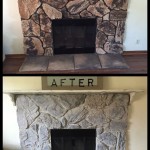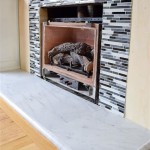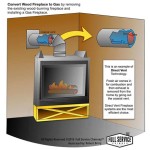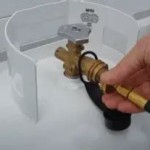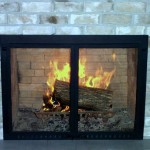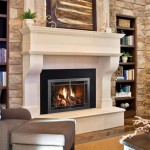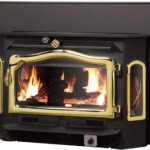How to Change A Brick Fireplace
Brick fireplaces, while often a charming architectural feature, can sometimes feel dated or clash with a homeowner's desired aesthetic. Updating a brick fireplace can dramatically alter the look and feel of a room, providing a more modern, rustic, or contemporary ambiance. This article details several methods for changing a brick fireplace, ranging from simple cosmetic updates to more involved structural alterations.
Before undertaking any project, it's crucial to assess the fireplace's condition. Look for cracks, crumbling mortar, or signs of water damage. These issues must be addressed before proceeding with any cosmetic changes. Ignoring structural problems can lead to more significant and costly repairs down the line. Furthermore, check local building codes and regulations, especially if the planned changes involve structural alterations to the fireplace or chimney. Permits may be required, and compliance with safety standards is paramount.
Cleaning and Preparation
Regardless of the chosen method for changing the brick fireplace, thorough cleaning and preparation are essential. Over time, brick can accumulate soot, dust, and grime. A clean surface is necessary for paint or other coatings to adhere properly. Begin by removing any loose debris with a stiff brush or vacuum cleaner. For stubborn stains, use a specialized brick cleaner according to the manufacturer's instructions. These cleaners typically require application, dwelling time, and rinsing. Protect surrounding areas with drop cloths and painter's tape to prevent damage from cleaning solutions.
After cleaning, inspect the mortar joints. If any are crumbling or missing, repointing (replacing damaged mortar) is necessary. This process involves carefully removing the old mortar with a chisel and hammer, then applying new mortar using a tuckpointing trowel. Allow the new mortar to cure fully before proceeding with any further changes. Ensure the mortar matches the existing mortar in color and texture for a seamless repair. This preserves the structural integrity and aesthetic consistency of the fireplace.
Painting the Brick
Painting is a relatively straightforward and cost-effective way to transform a brick fireplace. It allows for complete color changes and can instantly modernize a dated fireplace. However, it's crucial to use the correct type of paint and follow proper application techniques. Latex paint is commonly used for brick fireplaces, but masonry paint is a better option as it is specifically designed for porous surfaces like brick. Masonry paint is more breathable, allowing moisture to escape from the brick and preventing paint from peeling or blistering over time.
Before painting, apply a masonry primer to the cleaned brick surface. Primer helps to seal the brick, creating a uniform surface for the paint to adhere to. It also prevents the paint from being absorbed into the porous brick, reducing the number of coats needed for full coverage. Allow the primer to dry completely before applying the paint. Use a brush to apply paint to the mortar joints and any irregular surfaces. A roller can be used for the flat surfaces of the brick. Apply multiple thin coats of paint rather than one thick coat to avoid drips and ensure even coverage. Allow each coat to dry thoroughly before applying the next.
Consider the desired finish when choosing a paint. Flat paint provides a matte finish and minimizes imperfections in the brick, while semi-gloss paint is more durable and easier to clean. High-gloss paint is the most reflective and can add a dramatic touch, but it also highlights any imperfections in the brick. Experiment with different paint colors and finishes to achieve the desired aesthetic. White paint can create a clean and modern look, while dark colors can add warmth and drama. Neutral colors are versatile and can complement a variety of decorating styles.
Adding a Fireplace Surround
Adding a fireplace surround is another way to dramatically change the appearance of a brick fireplace. A surround is a decorative structure that frames the fireplace opening. It can be made from a variety of materials, including wood, stone, metal, or tile. A surround can be installed over the existing brick, completely concealing it, or it can be designed to complement the brick, creating a more cohesive look.
When choosing a surround, consider the style of the room and the desired aesthetic. A classic wood surround can add warmth and elegance, while a modern metal surround can create a sleek and contemporary look. Stone surrounds are timeless and can add a touch of rustic charm. Tile surrounds offer endless possibilities for customization, allowing for intricate patterns and designs. Measure the fireplace opening carefully to ensure the surround fits properly. It's often advisable to hire a professional to install the surround, especially if it's made from heavy materials or requires precise fitting.
Installation typically involves attaching the surround to the existing brick using construction adhesive and screws. The adhesive provides a strong bond, while the screws provide additional support. Ensure the surround is level and plumb before securing it in place. Once the surround is installed, caulk any gaps between the surround and the brick to prevent drafts and create a seamless finish. The surround can be painted or stained to match the room's décor, further enhancing the fireplace's new look.
Applying a Brick Veneer
For a more permanent and realistic change, consider applying a brick veneer over the existing brick fireplace. A brick veneer consists of thin slices of real brick that are adhered to the surface of the existing brick. This allows for a complete transformation of the fireplace's appearance without the need for demolition or reconstruction. Brick veneer is available in a wide variety of colors, textures, and styles, allowing for a customized look.
Preparation is crucial for a successful brick veneer installation. Clean the existing brick thoroughly and repair any cracks or crumbling mortar. Apply a bonding agent to the brick surface to promote adhesion of the veneer. Measure and cut the brick veneer to fit the fireplace. A wet saw is typically used to cut brick veneer cleanly and accurately. Apply thin-set mortar to the back of each brick veneer and press it firmly onto the brick surface. Use spacers to maintain consistent joint widths between the bricks.
Work in small sections, applying the veneer one row at a time. Periodically check the alignment of the bricks to ensure they are level and plumb. Once the veneer is installed, allow the mortar to cure completely. Then, apply grout to the joints between the bricks. Choose a grout color that complements the brick veneer. Use a grout float to press the grout into the joints and remove any excess grout from the surface of the bricks. Allow the grout to dry and then wipe the bricks clean with a damp sponge. The resulting fireplace will have the authentic look and feel of a completely new brick fireplace.
Whitewashing or German Schmear Techniques
For a more subtle change that still retains the character of the brick, consider whitewashing or applying a German Schmear. Whitewashing involves applying a diluted coat of white paint to the brick, allowing the natural texture and color variations to show through. This creates a soft, aged look that can brighten up a room without completely covering the brick. The German Schmear technique uses mortar instead of paint, creating a more textured and rustic appearance.
To whitewash a brick fireplace, mix white latex paint with water to create a thin wash. The ratio of paint to water will determine the opacity of the whitewash. Experiment with different ratios to achieve the desired look. Apply the whitewash to the brick using a brush or roller. Wipe away any excess whitewash with a damp cloth to allow the brick's texture to show through. Apply multiple coats of whitewash for a more opaque finish. For the German Schmear technique, apply wet mortar directly to the brick surface, working it into the joints and spreading it unevenly across the brick. Use a damp sponge to remove some of the mortar, creating a textured and rustic look. These techniques can be customized to achieve a variety of styles, from subtle and understated to bold and dramatic.
Removing the Brick Fireplace Altogether
In situations where the brick fireplace is no longer desired, removing it entirely is an option. This is a more significant undertaking that requires careful planning and execution. It's essential to consult with a structural engineer to ensure the removal of the fireplace won't compromise the structural integrity of the house. The engineer can assess the fireplace's construction and recommend any necessary support measures.
Before starting the demolition, disconnect any gas lines or electrical wiring associated with the fireplace. Protect surrounding areas with drop cloths and plastic sheeting to contain dust and debris. Use a sledgehammer and chisel to break apart the brick, working from the top down. Wear safety glasses, gloves, and a dust mask to protect yourself from injury and dust inhalation. Remove the debris as you go. Once the brick is removed, inspect the area for any structural issues and address them accordingly. Patch any holes in the walls or floor. The space can then be repurposed for other uses, such as a built-in bookcase or a media center.
Removing a fireplace can significantly alter the room's layout and appearance. It's important to have a clear plan for the space after the removal is complete. This may involve hiring contractors to perform structural repairs, electrical work, or plumbing. It's also important to dispose of the brick debris properly. Contact your local waste management company for information on disposal options.
Changing a brick fireplace involves a range of options, each with its own level of complexity and impact. From simple cleaning and painting to more involved modifications like adding a surround or applying a brick veneer, homeowners can transform their fireplaces to better reflect their personal style and enhance the overall aesthetic of their homes. Careful planning, proper preparation, and adherence to safety precautions are essential for a successful outcome.

16 Red Brick Fireplace Makeover Ideas

16 Red Brick Fireplace Makeover Ideas

Brick Fireplace Makeover Before And After Ideas Cool Makeovers Remodel Home Red Fireplaces

Mortar Wash Brick Fireplace Makeover Dimples And Tangles
:max_bytes(150000):strip_icc()/MadetobeaMommaBefore-5bb2476446e0fb002607ad4f.jpg?strip=all)
Before And After Fireplace Makeovers

10 Gorgeous Ways To Transform A Brick Fireplace Without Replacing It Hometalk

25 Beautiful Diy Brick Fireplace Makeovers

Removing A Brick Fireplace

Brick Fireplace Makeover Before And After Decorating Painting Id Painted Fireplaces Paint

Diy Red Brick Fireplace Makeover Ideas The Nuts

